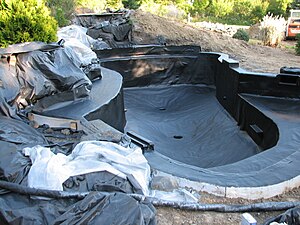 Image via WikipediaHow to Get Your Koi Pond Equipment Set For Winter
Image via WikipediaHow to Get Your Koi Pond Equipment Set For WinterWith respect to the climate in your area you will need to evaluate if you are going to run your pump and filter system through the winter.
If temperatures mostly stay well above freezing then it would be advantageous to keep your pump and filter running during the entire winter. The bacteria with your biological filter will probably be inactive at low temperatures. But, so long as you keep it supplied with oxygen-laden water the bacteria will continue alive.
The advantage of this is that when spring comes along with the water temperature rises, the bacteria can immediately take effect to keep the lake quality beneficial to your fish. It'll likewise be helpful in managing algae.
Should you choose run your filter from the winter it will be best to minimize water circulation so that you can take advantage of the layering effect with the water. You dont want to stir up the nice and cozy water through the bottom and chill it by mixing it with all the cold water from the upper parts of the pond.
Some of the things you can do with your koi pond equipment to reduce the water circulation would be to turn off bottom drains, place the intakes to pumps/filters at mid-water rather than close to the bottom or top of your pond, place your intakes for waterfalls or fountains more detailed the outlets, let down surface skimmers, and/ or turn the pump down.
Performing these things will permit the bacteria inside the biological filters to keep alive without disturbing the layering with the water. The river is densest at 39 degrees. As long as your pond can be a minimum of one meter deep you will have a layer of 39 degree water at the end of your pond where your koi can hang out during the cold months.
Excessive circulation of water in the winter months can super chill water by exposing warmer pond water at the end to the below freezing temperatures nearby the top, thus inducing the death of your koi.
One problem to watch out for if you run a pump and filter in the winter months is the potentially major damage that can be caused in your filter and plumbing system by way of a power outage that lasts for any extended time frame.
If you aren't where you can make sure that no water remains inside the filter and plumbing, plus it freezes UV's and filters, they could break. This may mean costly replacement expenses of your respective koi pond equipment.
There are two alternatives to allowing this to take place. First, you may install a check velve in your metabolism, using a long piece of tubing or wire to hold the valve open, thus allowing the water to drain out. Or, in case your system is designed to allow the water to flow back into the pond in the case of a power outage,you wouldn't need to make any alterations in any respect!
Of course, you can choose to do the entire opposite of this using your koi pond equipment through the winter, and totally de-activate your pumps and filter.
Cold water holds much more oxygen than domestic hot water and your koi's respiration is slow. Don't need aeration or circulation.
It's not essential to maintain your bacteria within your filter alive either, the only reason for running the filter to begin with.
If you turn off your koi pond equipment for your winter be sure to drain all plumbing. External filters, UV's, and external pumps all need draining. When you don't want the seals to dry out you should leave submersible pumps within the pond or perhaps in a bucket of water in a very warm place for the winter.
If this describes what you decide to do, be sure to clean the filter thoroughly prior to starting things support in the spring.
If ice will freeze in the pond locally you will need to include a floating de-icer to help keep an area free of ice. This opening is important during periods of ice cover allowing an exchange of gases. You don't want noxious gases trapped under the ice along with your koi, or they will often not be alive in the spring!
If you follow these simple tips in the winter you should have no trouble using your koi pond equipment.

No comments:
Post a Comment